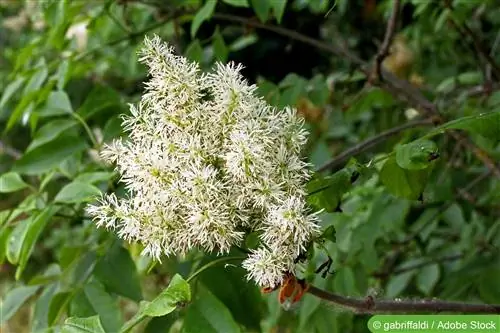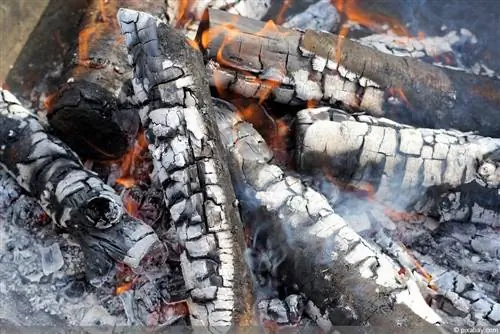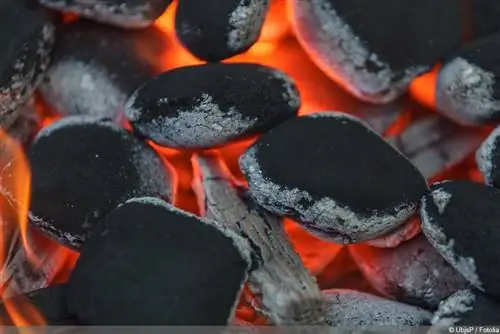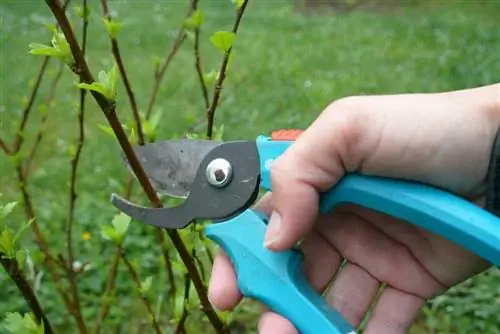- Author admin [email protected].
- Public 2023-12-17 03:39.
- Last modified 2025-06-01 06:48.
A manna ash, also known as a flower ash, is a medium-sized tree that is quite beautiful to look at and can be a lot of fun as a house tree, especially in the warm season. Due to its somewhat more modest size, it fits perfectly in the garden or in front of the house and can provide a lot of shade in summer and offer songbirds a nice home. However, to ensure that the Manna ash always looks well-groomed, it needs to be handled regularly.
Manna ash - size as an advantage
The Manna ash or flower ash only grows to around 10 meters tall, which makes it so popular as a house tree. In addition, on average it does not grow more than 20 cm per year and therefore requires little work in terms of care and cutting. Its round crown not only produces lots of green leaves, but also blooms in May and June. The white flowers not only look beautiful, but also smell very pleasant. In autumn the leaves turn purple and are a great eye-catcher. And since it requires little water, tolerates heat well and has few problems with air pollution, it can easily find its new home in the middle of a big city. All in all, the medium-sized tree is a good alternative to large oaks or other trees that are more complex to care for and handle.
Care
House trees like the Manna ash are actually quite uncomplicated to care for. You are grateful if you can call a sunny and sufficiently large place your own where you can grow and thrive in peace.
The following things must be taken into account:
- the Manna ash requires little water
- she loves it sunny and warm
- no special soil or fertilizer is required
Planting
Autumn or winter should be chosen for planting Fraxinus ornus. The trees are leafless at this time of year, making them easier to manage. In addition, they are often only offered in tree nurseries and garden centers at this time. As a rule, the trees are available without pot balls. The roots are bare and the still small tree has been cut back quite heavily. It should therefore be brought into the ground as quickly as possible so that it does not suffer major damage.
However, if the Manna Ash can be purchased in a container, planting does not have to be done immediately. The tree then has enough soil to stay in the container for a few days. It would be important that it is relatively sunny and that it gets some water every now and then.
Tip:
The Manna ash should be planted in the cold season. However, this only works if the ground is not frozen.
Location
A Manna ash tree likes it warm, dry and sunny. It should therefore only be planted in appropriate areas. The soil should not be too moist, otherwise the roots could become moldy and the moisture will not help the tree grow. Despite preferring warm temperatures, the Manna ash is not sensitive to frost. However, the prerequisite for this is that it has grown well beforehand. Fraxinus ornus does not need any special protection for the winter such as a tarpaulin or a ring around the trunk. The floor doesn't need to be covered either.
Growth
Since the Manna Ash grows very slowly, the tree should be supported in the first few years. The trunk is initially very slender and could quickly break if there is strong wind or careless people and animals. With appropriate support, prevention can be achieved and the tree can grow in peace.
Watering and fertilizing
In principle, the Manna ash does not need to be watered additionally. It should only be given some water in the first few weeks after planting. Otherwise, the water that the rain brings is enough for her. Exceptions only exist if there is a very long dry period. Then it can't be a bad idea to pour a few cans of water onto the tree. The roots will absorb water quickly and store it for a long time. And there are no special rules when it comes to fertilizing either. The tree is very easy to care for and does not require any special fertilizer. If there is some humus left, you can incorporate it into the soil around the tree. But it is not urgently needed for growth. Chemical fertilizers should not be used at all as they play no role in the development and growth of the tree.
Positive characteristics
If cared for well, the Manna ash makes wonderful firewood. The calorific value is about as high as that of a beech or an oak. Cut branches therefore do not have to be disposed of, but can be burned.
Tip:
The branches do not need to be dried in advance. They burn just as well fresh as they do dry.
In addition, the wood of the Manna ash is very hard and at the same time elastic. It is often used in the furniture industry for the production of high-quality parquet or stairs, furniture and sports equipment. If you have children, you can also make a wonderful flying bow out of the branches. The branches are so elastic that the bow will shoot many arrows.
Cutting
You should be very careful when pruning the Manna ash. The trees grow very slowly and therefore do not need to be constantly cut back. This is only recommended if some branches become too long or overlap with other branches. Then you can use hedge trimmers in spring and the tree will have a new look. A cut would also be conceivable if the tree only needs to reach a certain height because there is not too much space available.
Tip:
If the tree is cut, it often happens that in the following early summer the tree's blossoms are somewhat less.
Frequently asked questions
Is the Manna Ash tree hardy?
Yes. The Manna ash can easily survive even a very cold winter. However, the prerequisite for this is that it has grown well and that the roots have sufficient nutrients and support in the soil.
When can Fraxinus ornus be planted?
As with all trees, planting is recommended in the cold season when the tree has no leaves. However, the ground must not be frozen.
Why does the manna ash require so little water?
The tree is so popular as a house tree because it is very easy to care for. Its low water consumption is due to the fact that it can store water very well. If it rains, it absorbs as much water as possible and can then use it in good doses. Watering therefore only needs to be done during very long dry periods.
What you should know about the Mana Ash tree soon
Cultivate as a house tree
The flower ash (Fraxinus ornus) grows up to ten meters high, but grows very slowly at around 20 cm per year and is therefore also suitable for smaller gardens. It forms a round crown and blooms from May to June with numerous white flowers that smell very good. But its feathery foliage, which turns slightly purple in autumn, is also very decorative. This tree is also suitable for urban areas because it copes well with heat, drought and air pollution. It can stand alone, but is also often used as a street tree for an avenue.
Cultivate as a standard tree
The flower ash is also sold in garden shops on a standard tree and can be cultivated as a container plant on the terrace because of its slow growth. In this case, however, the pot should be wrapped with fleece or bubble wrap during the winter to protect the root area from frost.
Care and cut
- House trees are best planted in the leafless period from October to March and are usually only available in tree nurseries during this time.
- There they are usually sold bare root, i.e. without pot balls, and should therefore be planted as quickly as possible - but only if the ground is not frozen.
- The flower ash grows best in warm and dry areas and should therefore be given a place that is as sunny as possible with soil that is not too moist.
- Once it has grown well, it is very frost hardy and therefore does not require any special protection for the winter.
- Pruning is usually not necessary, but if necessary, branches that are too long can be shortened in spring.
- In this case, however, it can be expected that the flowering will be lower the following summer.
Use in medicine
When branches and twigs of the flower ash are scratched, a sap comes out of them, which quickly hardens when exposed to air. This juice contains, among other things, mannitol, a sugar alcohol also called mannitol. This substance is used in medicine to treat various diseases and for prophylaxis. These include, for example, poisoning, but also prophylactic treatment after an operation to prevent kidney failure.






